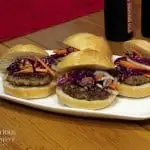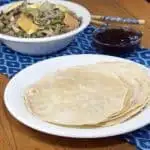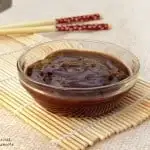Duck fat is a wonderful fat to use for cooking. And, if you’re roasting a duck in the oven, rendering the duck fat while you roast it is an easy way to use your duck to its fullest.

Sometimes when we render duck fat, we’ll brush the duck with a glaze near the end of roasting time and make ourselves some Peking Duck.
Why Would You Want to Use Duck Fat?
When we traveled to Poland, we were introduced to duck fat.
It sounds bizarre to us State-side, but think of it like bacon grease.
Anytime we cook bacon, we save the grease and keep it in a jar in our fridge. Just a little is all you need to add incredible flavor to fried eggs, sauteed veggies or hash-brown potatoes.
Duck fat does the same thing.
And, it makes PHENOMENAL roasted potatoes.
After having potatoes roasted in duck fat while we were in Poland, we decided that we needed to get our hands on the stuff for cooking at home.
How To Render Duck Fat
Rendering is basically separating the fat from a substance by extended cooking at a low temperature.
This can be done to any kind of meat or even to butter to separate the fat from the milk solids, creating what is called clarified butter.
To render the fat from our duck, we used the dry rendering method of oven roasting.
By cutting cross-hatched slashes into the duck fat (being careful not to pierce the meat), we expose a larger surface area of fat, helping it to melt.
The trick is to re-slash the duck every hour or so, to expose more of the fat, rather that keeping it locked inside the dry ‘skin’ that forms as you roast.
Benefits Of Duck Fat
Duck fat has a high smoke point and a rich flavor, making it great for sauteing or frying.
It will keep in the refrigerator for months, or it can be frozen.
Many people tend to steer clear of saturated (hard) fats, particularly animal fats, but more and more research is showing the benefits of saturated fats (in moderation) in a healthy diet.
Take a look at our post on cooking fats if you’d like to learn more.
How To Use Duck Fat
Duck fat can be used in place of other fats in nearly any dish! Here are some of our favorite ways to use duck fat:
- Popcorn
- Roasted potatoes
- Sauteed mushroom
- Frying
- Mayonnaise
- Pie crust (just a little, particularly good for savory pies)
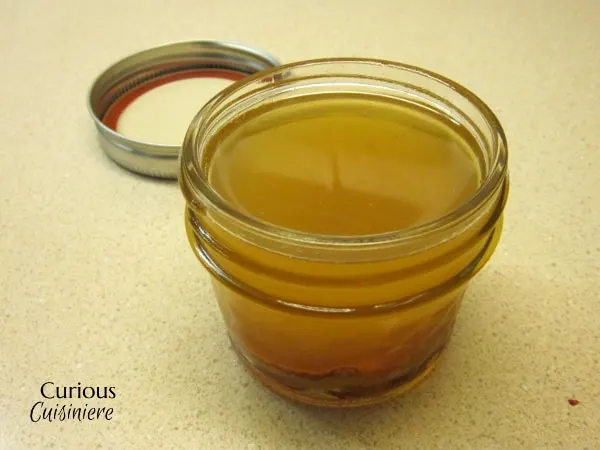
How To Choose A Duck For Roasting
When choosing a duck, look for the breeds Pekin (not to be confused with the Peking style of seasoning a duck) or Long Island, which are milder in flavor (and technically the same breed).
Leaner than Pekin, Muscovy Ducks often have a strong flavor that can be considered gamy.
The duck we roasted for today’s post just so happened to be a Pekin Duck from Maple Leaf Farms. We found it to be incredibly juicy and not overly greasy.
Cooking Duck
Duck is known for it’s distinctive flavor and moist, dark meat.
The animal is different from chicken or turkey in that they have a long and thin frame and do not have a large breast-section.
Duck is often thought of as a being greasy with sometimes tough meat, which is where a first step of rendering the fat really comes in handy.
By rendering the fat (which is primarily in the skin) you are left with the lean meat. And, the low and slow cooking tenderizes the meat beautifully.
Not to mention, after rendering, the skin takes on a wonderfully crisp texture.
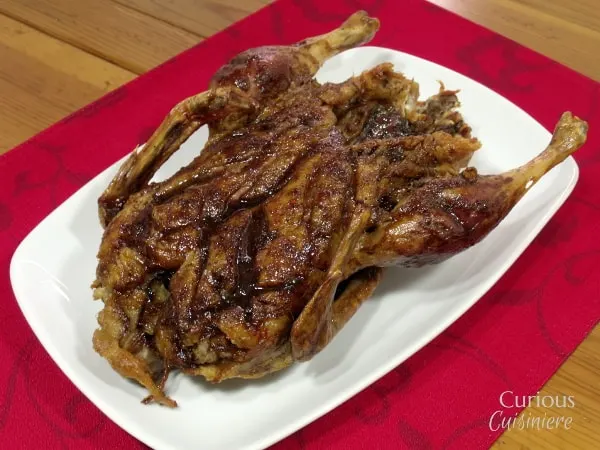
How To Use Your Roast Duck
After rendering the fat from our Pekin duck, we bathed the crispy skin in a Peking Duck glaze and placed it back i
nto the oven for 10-20 minutes caramelized the sauce slightly, giving it that classic Peking Duck flavor and quality.
We served our Peking Duck with a delicious Plum Sauce and Mandarin Pancakes.
How To Render DuckFat
Ingredients
- 5 lb whole duck, thawed and gizzards removed
Instructions
- Preheat your oven to 325F.
- Score the thick fat on all sides of the duck in a diamond pattern, being careful not to slice through the meat.
- Place the duck on a roasting rack, and place the rack in am aluminum-foil-lined roasting pan, or other baking dish with at least 2 inch high sides. (You don't want the duck sitting in its rendered fat. A roasting rack will get it off of the bottom of the pan, allowing the fat to collect below.)
- Roast the duck for 3 hours. Every hour, re-slash the fat and flip the duck over. (You can drain any fat from your roasting pan at each hour, or just wait to collect it all at the end.)
- The duck is cooked when the juices run clear and the leg bone moves easily in the socket.
If you liked this recipe, here are some similar dishes you may enjoy!

Sarah founded Curious in 2010 as a way to save her recipe creations and share culinary experiences. Her love for cultural cuisines was instilled early by her French Canadian Grandmother. Her experience in the kitchen and in recipe development comes from over 10 years working in professional kitchens. She has traveled extensively and enjoys bringing the flavors of her travels back to create easy-to-make recipes.



